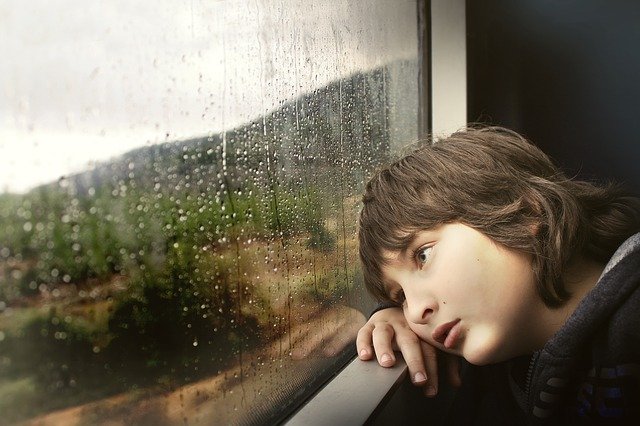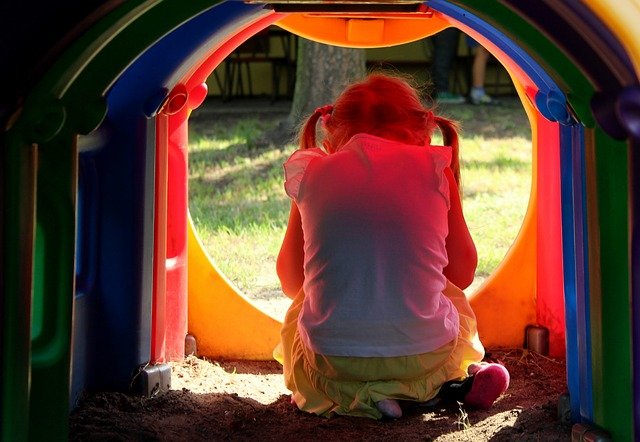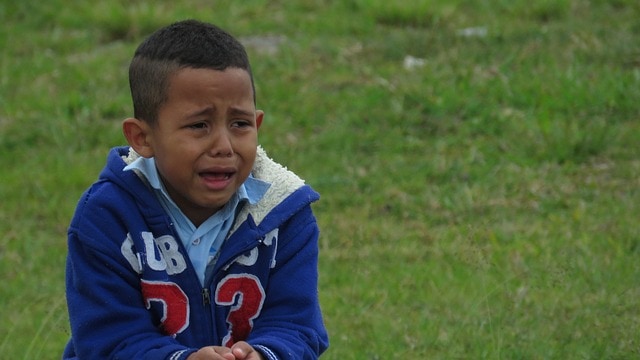Anxiety is a necessary evil because it forms a part of our survival instinct. This is the way your brain and body respond to potential threats, telling you to overcome or run away from certain stressors. It is a normal reaction in all of us but some individuals have a quicker and more elevated reaction to perceived threats. With stronger reactions and symptoms, it can be harder to manage anxiety, especially for children. If your child experiences anxiety, you will have to learn how to deal with anxiety in a child before you can help them vanquish their demons.

Symptoms of anxiety in adults and children
As an adult, you recognize the symptoms of anxiety in yourself. Your heart beats faster, your palms may be damp, you may perspire more, and you feel breathless or unable to draw a full breath. Many people feel tension in their shoulders and neck or get tension headaches.
All these symptoms prepare your body for flight and are usually only apparent for a short time while you are stressed. It becomes a mental health condition known as anxiety disorder when anxiety is a frequent or common response to everything.
When it comes to kids, it can be hard for parents to distinguish between normal child anxiety and a more serious mental condition. This can make it difficult for you to understand how to deal with anxiety in a child.
It is normal for your child to be worried about the following things:
- Feeling anxious about school and homework
- Worrying about health when sick or when a family member or pet is sick
- Being shy in new situations or when being mocked
- I dread being left alone at childcare or school
If your child displays higher levels of anxiety than other children of their age or if their anxiety prevents them from taking part in daily life, you should talk to an expert.
How to deal with anxiety in a child – Recognizing problematic behaviour
There are certain patterns of behaviour that you can watch out for. Being able to spot them will help you learn how to handle anxiety in children.
Here are some behaviour patterns that you should watch for:
- Complains repeatedly of headache and stomach ache, especially in unfamiliar surroundings
- Frets and worries about minor issues
- Desires things to go their way and easily gets upset when they do not, often crying
- Avoids or steers clear of certain situations
- Has nightmares or trouble sleeping
- Forces you to do things that they stress about
- Feels tired all the time
- Constantly feels annoyed and irritated
- Is unable to concentrate
- Avoids trying new activities
- Constantly seeks reassurance and validation
- Clings to adults obsessively
- Refuses to get ready for school or other social situations

How to handle anxiety in children – Understanding the type of anxiety your child has
Six common types of anxiety are usually experienced by children. If you’re learning how to deal with anxiety in a child, you should know these:
- Phobias
- Obsessive Compulsive Disorder
- Social anxiety or phobia
- Separation anxiety disorder
- Generalised Anxiety Disorder
- Post-Traumatic Stress Disorder (PTSD)
Besides these medically recognized anxiety disorders in children, there are several generalized fears. As they grow older and learn more about the world, the list of fears may grow and require you to know how to deal with anxiety in a child.
While some fears tend to be based on realistic events, many may be imaginary. Some of the common fears include:
- The dark
- Separation or divorce
- Monsters
- Ghosts
- War or fights in general
- Death
- Robbery or crime
- Specific animals or birds
How to deal with anxiety in a child – Understanding the impact on a child
Anxiety affects how children think and feel, but also how they behave or interact with the world around them. With their vivid imaginations, they are likely to see their fears as much more threatening than they are.
If your child identifies a situation that makes them feel anxious, they may try to avoid it or ask you to deal with it. This is a way of avoiding a trigger but it’s not the best way to learn how to handle anxiety in children.

Avoiding a situation may resolve the problem in the short term, and this is especially attractive for parents who deal with frequent tantrums or crying. But in the long run, avoiding a trigger reduces the child’s ability to confront and deal with things that make them uncomfortable. This makes it harder for them in their daily lives because they lose confidence and feel incapable of handling even minor stressors at home or school. If you’re worried about how to handle anxiety in children with behavioural problems, you should consult a specialist.
How to support a child with anxiety
As you learn how to deal with anxiety in a child, you must understand that anxious behaviour is a fairly common occurrence. As children are introduced to new environments and new people, they may feel overwhelmed but with some help from the parent, this should blow over.
For parents or caregivers looking for tips on how to handle anxiety in children, here are some ways to offer support:
- Providing gentle encouragement to do the things that provoke anxiety
- Ensuring that you never label them as ‘shy’ or ‘anxious’, especially in front of others
- Giving them rewards and praising their efforts when they handle tasks that are hard for them
- Acknowledging their worries and not being dismissive about them
- Try meditation for kids to teach them how to deal with anxiety
- Encouraging them to handle their fears but stepping in when necessary to help resolve them
When to seek help
Anxiety in children is a normal response to their experience of growing up and being exposed to new places, people and situations. Anxious responses to these stimulants are considered normal and can be handled by parents and teachers.
However, when it appears to be an anxiety disorder, it should not be taken lightly. Do not assume that it will go away or get better on its own. While you need to learn how to handle anxiety in children at home, it is advisable to get help when the symptoms seem serious.

If you think your child is experiencing more anxiety than the situation deserves or if you suspect an anxiety disorder, you should speak to a specialist. Watch out for these signs:
- Anxiety hampers their ability to go about their daily activities
- Their anxiety is more intense than the situation warrants
- Their level of anxiety seems higher than other children of similar age
- Anxiety produces somatic symptoms such as headaches, diarrhoea and stomach pain
- It is getting harder for you and your child to handle their anxiety
Mental health is always important, but in the formative years, the mental health of your child has an impact on its development and behaviour. You could consider getting professional advice on how to handle anxiety in children from the following sources:
- Your family doctor
- Child and family health service
- A mental health clinic
- School counselor
- A child psychologist
You should especially seek medical intervention if your child suffers from a specific anxiety condition or has conditions that increase anxiety. If your child’s anxiety is debilitating, the expert may recommend that you find a psychologist or try therapies such as cognitive behaviour therapy (CBT) or in extreme cases, medicines.
Myths about anxiety in children
Many cultures believe that mental health conditions are “all in the mind” or that they are something to be ashamed of. With these apprehensions, taking action towards better mental health is viewed as something to be done in secret or not done at all.
For child anxiety disorders, it is important to get the right advice (and treatment if necessary) as soon as possible. A child doesn’t understand why he is behaving in a certain way or feeling things that other kids don’t seem to feel. This can cause feelings of inadequacy, low self-esteem, and other issues that may require treatment.
One of the other myths when considering how to deal with anxiety in children is not wanting to teach a child about fear. While you may want to protect your children from harsh realities, it is important to teach them about things like fire, crossing an intersection, talking to strangers, and other things that are risks to them.
It can be hard to know how to handle anxiety in a child and still have these discussions. Do remember that anxiety is a useful feeling because it allows us to be cautious and take the right action against potential threats, but you will have to moderate your discussion to teach them to be fearful in appropriate amounts. Talking to a counsellor online or consulting a child specialist can help you do this.
How to handle anxiety in children – Do’s and don’ts
As you understand how to deal with anxiety in a child, you will see that some tactics work where others do not. While this can vary from child to child, here are some general tactics and tricks that are usually effective:
- Acknowledge their fears and get them to talk about their emotions and feelings
- Allow them time to acclimatize to new situations and environments
- Accept that it might be necessary to help your child avoid their object of fear for some time
- Encourage them to ask questions and give truthful answers
- Build up their resilience and mental fortitude to tackle their objects of fear. Start slowly and guide them through the baby steps as they build up confidence
- Inculcate routines and habits to provide a sense of security to improve confidence and alleviate anxiety
- Ensure that the TV they watch or the books they read are moderated and age-appropriate
- If there are older siblings in the house, teach them how to influence their anxious younger siblings and ensure they are not upsetting the child with inappropriate stories or television
- Establish a bedtime routine or try sleep meditation for kids to encourage a good night of sleep, which is necessary for good mental and physical health
- Encourage them to spend time outdoors and socialize with other children of the same age
- Empower them with some choices. Provide them with a night light if they are afraid of the dark to teach them how to take control of their fear
- Reward them every time they take action, no matter how small, to face their fears
While the above tactics should help anxious children, do make sure they are not exposed to ridicule or mockery for their fears at home or in school.



